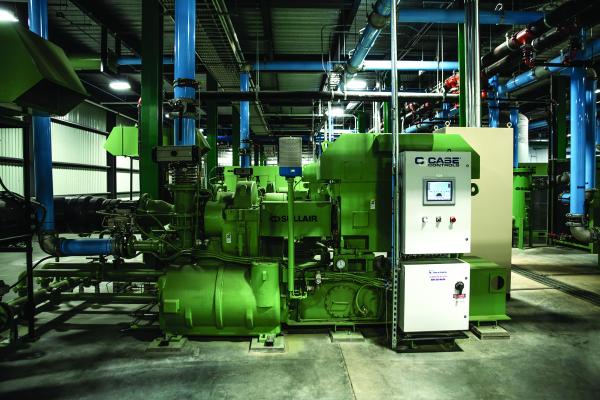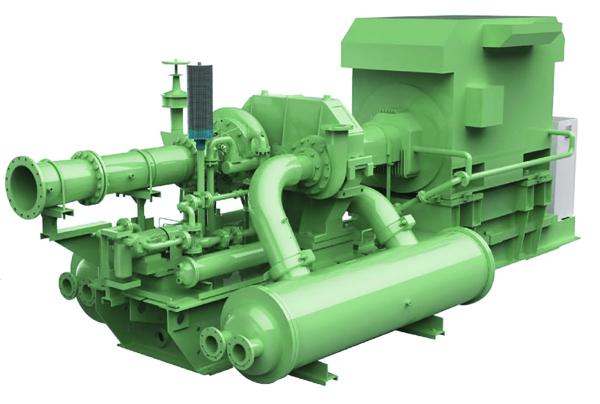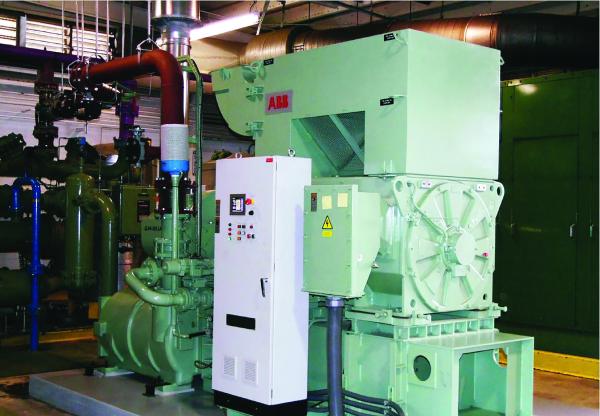The demands of maintaining an efficient and productive manufacturing operation are many. With an increased focus on environmental concerns and constant cost optimization initiatives, machinery purchase decisions are more important than ever. When selecting an air compressor for your manufacturing operation, the common choice is the industry-standard rotary screw compressor. Known as the work horse of compressed air machinery, the rotary screw compressor comes in a multitude of sizes and power levels. However, centrifugal compressors have seen some exciting technological progress in recent years and offer a wide range of pressures, flow and turndown. Long known for their longevity and durability, they offer higher efficiency, even qualifying for energy rebate programs offered by local utilities and all, notably, produce Class 0 oil free air.
When choosing your air compressor many factors play into making the right choice. Whether it is the variety of applications, cost and energy savings, reliability and longevity, modern centrifugal compressors can often be the smartest choice – depending on your application and manufacturing environment – making them worth a second (and first) look.

Centrifugal compressor at glass manufacturer.
But First, a Little History…
Before we take that look into why a centrifugal air compressor may be worth examining for your operation, it is interesting to note that centrifugal compressor technology has been around a long time. The origin can be traced back to the year 1689, when French physicist Denis Papin and Dutch physicist Christian Huyghens collaborated by experimenting with an air compressor, using centrifugal force to compress air. As the physics community gained a better understanding of fluid and thermal dynamics, the centrifugal compressor evolved from a crude single impeller blower into the multi-stage modern compressor we use today.
A Compressor for Every Plant Demand Scenario
History aside, this century, centrifugal compressors have traditionally been known as a baseload compressor and not suitable for compressed air systems with large changes in demand. This may be true of older models where the typical inlet modulation turndown using a butterfly style inlet valve was only 10-20 percent less than full flow. This means the compressed air system flow demand drops from 100 percent to 60 percent, the older design centrifugal compressor would inlet modulate down to 80 percent flow, deliver 60 percent flow to the compressed air system, and blow-off 20 percent to atmosphere. Wasting 20 percent of the air product is less than ideal, especially when efficiency matters.
Modern centrifugal compressors, however, have much more flexibility in turndown using a modern inlet guide vane inlet valve and can modulate beyond the 10-20 percent less air flow of early machines, up to 50 percent turndown. This is in part due to fast and powerful microprocessor controllers that run many control loops simultaneously as well as advances in computer aided impeller design. The modern inlet guide vane is mounted very close to the first stage impeller and imparts a beneficial “swirl” to the inlet airstream reducing turbulence and improving energy efficiency up to 8 percent compared to a butterfly inlet valve. The inlet guide vane precision blade design results in faster control valve responses, to changing demand, along with better overall energy efficiency. Having more turndown means the centrifugal compressor can be installed in a compressed air system with large flow variability and not blow-off during low flow applications. And, because of the nearly endless turn down scenarios, one centrifugal compressor can do the job of several smaller rotary screw compressors.
With this turndown flexibility, a wide range of pressures and flow, and with up to 10,000 hp, the modern, multi-stage integrally geared centrifugal air compressors can cover most applications. Automotive, steel, glass, food and beverage, air separation, large industrial manufacturing to chemical and petroleum processing applications are all possible. There are also custom seal designs available for specialty gas processing.

Centrifugal f-series.
Oil Free Air Comes Standard
The issue of oil free or Class 0 oil free air is becoming a hotter topic in manufacturing. The International Standards Organization (ISO) 8573.1 Air Quality Classes for compressed air defines contaminants allowed in the end product air. Oil free applications require Quality Classes “1” or “0” for total oil concentration. Less than 0.01 mg/m³ is Class 1 and anything lower than Class 1 is Class 0. As the most stringent air quality class, Class 0 ensures that a compressor discharges compressed air free of oil aerosols, oil vapors or oil liquids coming from the compressor.
In any application, compressed air directly or indirectly contacts the manufactured product. When using oil flooded air compressors, it is possible for the air to make it downstream and contaminate the product. In applications such as food and beverage, pharmaceuticals or sensitive technology manufacture, this contact with residual oil from a compressed air system has obvious consequences, making Class 0 air vital for maintaining product quality and the health and safety of consumers.
Thankfully, centrifugal air compressors are oil free by design. They produce Class 0 oil-free air making them ideal not only for sensitive manufacturing environments, but also for manufacturers looking to move away from oil flooded for sustainability or maintenance reasons. Sustainably speaking, centrifugal compressors use less oil than oil-flooded screw compressors – upwards of 55 more gallons of oil every 6-12 months. This oil along with oil-contaminated condensate needs to be disposed of properly. Condensate from a (oil-free) centrifugal compressor does not need special handling/disposal and may even be recycled.
Further, many multi-national manufacturers are moving to oil-free compressed air systems to protect themselves against potentially damaging effects—such as contaminating end product, damaging production equipment, causing downtime or damaging their brand’s reputation due to the low quality of the end product and/or product rejections. Class 0 oil free compressors help eliminate potential contamination as no oil or lubricant is introduced into the air compression process. Oil free just may be the wave (or at least a ripple) of the environment-forward future for most processes.

Sullair Centrifugal TRE 1000 hp Installation at chemical producer.
Efficiency and Cost Savings to Boot
As previously mentioned, centrifugal compressors provide superior energy efficiency for large volumes of air as advanced technology impellers are designed to match the required airflow and pressure. This means additional energy savings – in excess of $100,000 in some cases – and opportunities to qualify for most local government energy rebate programs. As an added bonus, oil-free air in general requires less filtration downstream and less product and equipment contamination. This means less maintenance and more cost savings, especially over the long-term life of the machinery.
Centrifugal compressors also provide low maintenance costs as they’re designed with many non-contacting internal components. This means less friction wear and minimal maintenance needs. Most centrifugal compressors run continuously up to two years between shutdowns for basic maintenance allowing more uptime and less downtime compared to other compressor types. And, that long life can be from 40-60 years as compared to 20-30 years for rotary screw air compressors. Not having to replace your mission-critical air compressor for decades to come is a comforting thought.
Understanding that centrifugal air compressors can and should be part of your short list when shopping for air compressor solutions for your manufacturing operation is half the battle. Knowing that there are benefits and options available beyond rotary screw compressors means more choices and better performance, efficiency and results - depending on your application. Do your research, but when the time comes, don’t forget to look at centrifugal compressors as a viable, durable and environmentally-sound option.
About the Author
Richard Huguenor is the Business Development Manager for Oil Free Products at Sullair and brings 22 years’ experience in the centrifugal compressor industry to his position. Richard joined Sullair in 2015 as a sales engineer in oil free products. He is currently responsible for market growth in the oil free in the North American region.
About Sullair
Sullair, founded in Michigan City, Indiana, in 1965, is a leading global provider of compressed air solutions. The company was one of the first to execute rotary screw technology in air compressors, and its machines are known throughout the world for their reliability, durability and performance. Sullair became a Hitachi Group Company in July 2017. For more information, visit www.sullair.com.
To read similar articles on Air Compressor Technology, please visit
https://www.airbestpractices.com/technology.
Visit our Webinar Archives to listen to expert presentations on Air Compressor Technology at https://www.airbestpractices.com/webinars.




